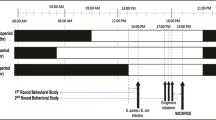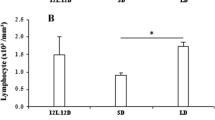Abstract
When mice infected with the Venezuelan equine encephalomyelitis (VEE) virus were exposed to 2500 lux with a 12 h light: 12 h dark photoperiod, the serum levels of melatonin (MLT) remained constantly elevated. In mice exposed to 400 lux low levels of serum MLT were detected during the day and high levels during the night. An increase in the survival rate of the infected mice from 6 to 13 days after virus inoculation was also observed. The significant increment in the concentration of serum MLT produced by the high intensity light could be responsible for the longer survival rate of mice infected with the VEE virus.
Similar content being viewed by others
REFERENCES
Krause, D., and Dubucovich, M. 1990. Regulatory sites in the melatonin system of mammals. TINS. 13:464–470.
Tamarkin, L., Baird, C., and Almeida, O. F. X. 1985. Melatonin: A coordinating signal for mammalian reproduction?. Science. 227:714–720.
Dollins, A., Lynch, H., Wurtman, R., Hua Deng, M., and Lieberman, H. 1993. Effects of illumination on human nocturnal serum melatonin levels and performance. Physiology & Behavior. 53:153–160.
Brzezinski, A., and Wurtman, R. J. 1988. The pineal gland: Its possible role in human reproduction. Obstet. Gynecol. Surv. 43:197–207.
Arendt, J. 1985. Mammalian pineal rhythms. Pineal Res. Rev. 3:161–213.
Lynch, H. J., Wurtman, R. J., Moskowitz, M. S., Archer, M. C., Ho, M. H. 1975. Daily rhythm in human urinary melatonin. Science 187:169–171.
Redman, J., Armstrong, S., and Ng, K. T. 1983. Free running activity rhythm in the rat: Entrainment by melatonin. Science. 219:1980–1081.
Wurtman, R. J., and Lieberman, H. R. 1985. Melatonin secretion as a mediator of circadian variations in sleep and sleepiness. J Pineal Res. 2:301–303.
Reiter, R. J. 1985. Action spectra, dose-response relationships, and temporal aspects of light's effects on the pineal gland. Ann. N.Y. Acad. Sci. 453:215–230.
Reiter, R. J. 1986. Normal patterns of melatonin levels in the pineal gland and body fluids of humans and experimental animals. J. Neural. Transm. Suppl. 2:35–54.
Lewy, A. J., Sack, R. L., and Miller, L. S. 1987. Antidepressant and circadian phase-shifting effects of light. Science. 235:352–354.
Azuma, H., Yamatodani, A., Yagi, A., Nishimura, T., and Wada, H. 1990. Influence of intensity of illumination during the light period on diurnal variations of pineal indoles in rats and mice. Neuroscience Letters. 119:15–18.
Underwood, H., and Hyde, L. L. 1989. Daytime light intensity effects night-time pineal melatonin levels in the lizard (Anolis carolinensis). Comp. Biochem. Physiol. 94:467–469.
Maestroni, G. J. M. 1995. T-helper 2 lymphocytes as peripheral target of melatonin signaling. J. Pineal Res. 18:84–89.
Ben-Nathan, D., Maestroni, G. J. M., Lustig, S., and Conti, A. 1995. Protective effects of melatonin in mice infected with encephalitis viruses. Archs. Virol. 140:223–230.
Bonilla, E., Ryder, S., and Hernández, H. 1975. Venezuelan equine encephalomyelitis virus infection: Effect on monoamines metabolism of mouse brain. J. Neurochem. 25:529–530.
Bonilla, E., Valero-Fuenmayor, N., Pons, H., and Chacín-Bonilla, L. 1997. Melatonin protects mice infected with Venezuelan equine encephalomyelitis virus. Cell. Mol. Life Sci. 53:430–434.
Weber, J., Hugentobler, M., Haldimann, D. 1996. 10th Annual Meeting of the American Sleep Disorders Association (APSS) and Sleep Research Society (SRS). Page 13. 28 May–2 June, Washington, D.C.
SAS Institute Inc, 1989. Guía Introductoria al S.A.S.® version 6.03, Page 117 SAS Institute Inc., North Carolina.
Reiter, R. J. 1991. Kynurenine and Serotonine Pathways. Pages 149–158 Schwarz R. (ed.), Plenum Press, New York.
Parfitt, A. G., and Klein, D. C. 1976. Sympathetic nerve endings in the pineal gland protect against acute stress-induced increase in N-acetyltransferase activity. Endocrinology. 99:840–851.
Lynch, H. J., Eng, J. P., and Wurtman, R. J. 1973. Control of pineal indole biosynthesis by changes in sympathetic tone caused by factors other than enviromental lighting. Proc. Nat. Acad. Sci. U.S.A. 70: 1704–1707.
Reiter, R. J. 1989. The pineal and its indole products: Basic aspects and clinical applications. Page 96–49 in Cohen, M. P. and Foa, P. eds. The Brain as Endocrine Organ. Springer, Vienna.
Author information
Authors and Affiliations
Rights and permissions
About this article
Cite this article
Medina, S., Valero-Fuenmayor, N., Chacín-Bonilla, L. et al. Exposure to 2500 Lux Increases Serum Melatonin in Venezuelan Equine Encephalomyelitis. Neurochem Res 24, 775–778 (1999). https://doi.org/10.1023/A:1020735730869
Issue Date:
DOI: https://doi.org/10.1023/A:1020735730869




